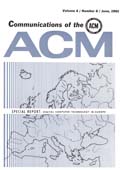June 1961 - Vol. 4 No. 6

Features
The state of digital computer technology in Europe
This report indicates the level of computer development and application in each of the thirty countries of Europe, most of which were recently visited by the author
Operational compatability of systems—conventions
This project is engaged in (a) a program of research into the application of the concepts and techniques of modern data processing to the design of mechanical parts, and (b) the further development of automatic programming systems for numerically controlled machine tools. The project is a cooperative venture between the Computer Applications Group of the Electronic Systems Laboratory and the Design and Graphics Division of the Mechanical Engineering Department, and is sponsored by the Manufacturing Methods Division of the USAF Air Material Command through Contract AF-33(600)-40604.
The ALGOL 60 Report,* when first encountered, seems to describe a very complex language which will be difficult to learn. The “metalinguistic formulae” admirably serve the purpose of precisely specifying a language, but they are certainly not very readable for a beginner. However, experience has shown that once the report is explained it is in fact easy to learn ALGOL and to write algorithms in it. The language is so general and powerful it can handle an enormous class of problems.
It is not hard to learn those parts of ALGOL present in other compiler languages: how to write assignment and go to and for statements, etc. Indeed, a lot of the unnecessary restrictions imposed by other compiling languages have finally been lifted. But ALGOL also allows many unobvious things to be written, as we will see later, and herein lies a problem: ALGOL seems to have become too general. So many restrictions have been lifted that a lot of technical details crop up which are hard to learn and to use correctly. In this paper some of the more obscure features of the language are considered and their usefulness is discussed. Remarks are based on the authors' interpretations of the ALGOL 60 Report.
Logic tables are an excellent way of developing and expressing the logic required in procedures, operations, systems and circuits. A set of rules for writing and using logic tables is explained by means of some simple examples. Then the logic structure of a vending machine is given in which two logic tables are used. Logic tables are two-dimensional in nature, enabling us to fully express and consider both the sequential and parallel aspects of logic. They can be compiled directly into a computer program and so eliminate the need for flow charting and hand coding.
On a class of iteration formulas and some historical notes
The class of iteration formulas obtainable by rational approximations of “Euler's formula” is derived with the corresponding error estimates. Some historical notes on iterative procedures are followed by a derivation of Euler's formula with the associated error estimate in a new notation which simplifies the error estimate and suggests generalizations. The final section considers the Padé approximants to the “Euler polynomial” and shows how a number of known formulas may be derived from this unified approach. There is a short discussion of the “best” formula.



